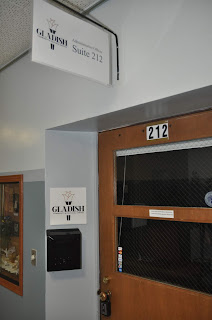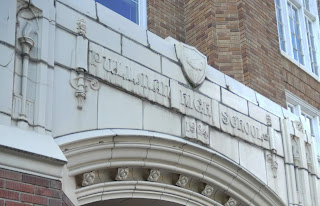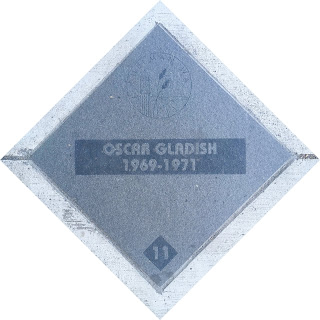Oscar Elijah Gladish was his full name.
But, “he was universally referred to as Mr. Gladish, not
only by students, but by faculty, school board members, and school patrons
alike. Nearly everyone in (Pullman) referred to him as Mr. Gladish, and few
ever called him by his first name,” wrote Donald E. Guinouard, see footnotes/sources.
Students held Mr. Gladish in great respect and affection. He
was usually the first person students visited after being out of town or away
from school. (Guinouard)
Mr. Gladish had an “acquisitive, judicious mind”. He was
both a “learner and a teacher all his working life,” wrote Wylie Johnston, see
footnotes/sources.
Mr. Gladish is the namesake of Gladish Community and
Cultural Center on West Main Street near downtown Pullman.
In its previous life, Gladish center was Pullman High
School/PHS. Mr. Gladish was the high
school principal and teacher of United States history and government for 34
years, 1929 to 1963.
Mr. Gladish wanted his students to earn their PHS diplomas.
But, the most important part of education, he thought, was teaching students to
think. (Guinouard)
When a new Pullman High School opened in 1972, the old PHS
was given a new name by the Pullman School Board: “Gladish Middle School.” It served
Pullman, 1972-1978. In 1996, Gladish Middle School (although no longer in
operation)/the old PHS was purchased from the Pullman School District and
renovated by the Friends of Gladish. Today it is Gladish Community and Cultural
Center.
Timeline:
Sept. 20, 1897 – Oscar Elijah Gladish born on a farm outside
of Higginsville Junction, Missouri, in the Kansas City area.
December 1900 -- At age 3 in December 1900, he moved with
his family to Idaho. They lived in Fruitland, on the Snake River near the
Idaho-Oregon border.
April 6, 1917 -- U. S. enters World War I.
1918 – Mr. Gladish graduated from Fruitland High School. During
his schooling, all grades he attended were taught in the same two-room school
house in Fruitland. Each school day, he walked two miles from the family farm
to school and back.
July 1918 to February 1919 -- He enlisted in the military,
but spent only a few months as an U.S. Navy apprentice seaman before discharge after
the war ended, Nov. 11, 1918.
February 1919 to September 1919 – Mr. Gladish worked for
Willamette and Columbia shipyards, Portland, using machinery to punch holes in
steel plates. Then, from early June to early September, he worked as a “tent
boy” for Ellis and White Chautauqua. It presented lectures and entertainment
under a big tent which traveled by train with chautauqua employees from city to
city. The Chautauqua circuit in which he worked -- starting in Richfield, Utah,
and ending in Laramie, Wyoming – included 82 towns, 40 in the U.S. and 42 in
Canada. (Johnston).
September 1919 – In Missouri and Idaho, Mr. Gladish’s family
attended Baptist churches, so it was not surprising his post-high school
education was at a small private Baptist college in Oregon’s Willamette Valley,
south of Portland. When he started his studies in late September 1919, it was called
McMinnville College. In 1922 the college name was changed to Linfield College when
Frances Ross Linfield donated Spokane properties to the college. According to the
Linfield “Oak Leaves” yearbook, as a student at the college Mr. Gladish was a member
of the college intercollegiate debate team, Delta Psi Delta fraternity, and
sang in the college glee. He also served on the YMCA Cabinet and was a member
of the Ministerial Association.
Spring 1923 – He graduated from Linfield College with a
bachelor’s degree in history and political science. (However, some sources say Mr.
Gladish earned a bachelor of philosophy degree in history, no mention of
political science.)
1923-1925 - After Linfield, Mr. Gladish wanted to attend law
school. He did not aspire to be an attorney, but wanted to broaden his
education by earning a law degree. But, he did not have the funds to pay for
law school. By teaching he earned money to pay law school tuition. He took a
teaching job in Apple Valley, Idaho, about 15 miles from Fruitland, where he
grew up. He taught 1912-1924. In the 1924-1925 school year he continued
teaching and also served as Apple Valley School principal. During his time in
Apple Valley he lived in Payette, Idaho, about 20 miles from Apple Valley. (Johnston)
May 30, 1925 -- He married former Linfield classmate Janet
Riley. She was a daughter of Linfield College President Leonard and Mrs. Julia
Riley. Janet graduated from Linfield in 1924 and taught at Payette, Idaho, High
School, 1924-1925. The wedding took place on the Linfield campus in the
President’s Home. Her father, a Baptist pastor, performed the ceremony. Her
twin sister, Ruth, was maid of honor. During the ceremony, Mrs. Linfield played
the Wedding March on the Riley family piano. The newly wedded couple moved to Springfield,
Oregon, near Eugene. Springfield put them near the Law School at the University
of Oregon in Eugene.
1925-1927 – Mr. Gladish entered the University of Oregon Law
School in Eugene in fall 1925. For the 1925-1926 and 1926-1927 academic years,
he rode his bicycle three miles from home to the Law School to attend classes. (Johnston)
1927 – His savings being depleted, Mr. Gladish left law
school and became a teacher at Springfield High School. Interesting to note
that during the Gladishes’ time in Springfield he preached at least once at
Springfield Baptist Church. (Johnston)
1927-1929 —Mr. Gladish taught at Springfield, Ore., High
School. The school principal’s job opened. He applied. Later he withdrew from
consideration after learning the contentious nature of the selection process.
Then, he signed with the Westmore Teachers' Agency in Spokane. Westmore told
him the Pullman High School “principalship” was open. Mr. Gladish applied and
was invited to interview. He traveled to and from Pullman by Northern Pacific
passenger train. Subsequently, he was offered and accepted the job. How did
word about Mr. Gladish’s appointment get out? One of the ways, according to “Hi
Times,” the PHS student newspaper, was an announcement in May 1929 made to the
audience attending a silent movie showing at the Cordova theater in downtown
Pullman. (Johnston.) (Frykman)
Aug. 12, 1929 – Mr. Gladish started as principal of (and
teacher at) Pullman High School. He greeted students on the first day of school
on Sept. 9, 1929. Although best known as Pullman High principal, “his real love
was teaching American history and government. Until he retired, he taught one
section of American history each semester. His knowledge of the subject was
prodigious and he could hold a class enthralled. At Pullman, he established a
high school student government system that was truly “of the students, by the
students, and for the students.” It was widely known and studied by educators
far and wide.” (Guinouard)
1932 —After graduate studies at Washington State College, he
earned a master of art’s degree in political science from WSC in 1932.
1950 – Although he left the University of Oregon Law School
in 1927, after two academic years of studies, he never gave up his interest in
law. In 1950 he earned a law degree from La Salle Extension University, a
nationally accredited private university based in Chicago. (Frykman)
1963 – Pullman High School graduation in 1963 was his last
as principal. Thirty-four years of service to a “single community mean (Mr. Gladish)
had survived – and perhaps surmounted – the Great Depression, the Second World
War, and eight high school generations of student.” (Frykman)
1963 – Mr. Gladish’ retirement was “filled with public
service and continued adherence to lifelong values and activities.” (Frykman).
June 19, 1967 – His wife, Janet Riley Gladish, age 66, died of
cancer in Pullman. Her death “plunged (Mr. Gladish) into a despondency from
which he escaped unexpectedly” when appointed City of Pullman mayor. (Frykman).
1969 – Mr. Gladish’s service as Pullman mayor began July 1,
1969, and ended Jan. 11, 1972. Poor health forced former Mayor W. T. Mitchell
to resign in June 1969. Mr. Gladish was named by the Pullman City Council to
serve out Mitchell’s unexpired mayoral term. He ran unopposed for the office in
November 1969. A story in May 21, 1971, “Lewiston Tribune” said Mr. Gladish’s
decision not to run again for mayor was based on his health and also because he
wanted more time to do “some things I have wanted to do for decades and have
not had time for.”
April 20, 1972 – The former Pullman High School was named
“Gladish Middle School.” Pullman’s School Board “accorded him perhaps the
highest mark of distinction and gratitude when, on April 20, 1972, it named the
building in which he served so long” for him. (Frykman.)
September 1972 – The
“new” Pullman High School on Military Hill opened.
Aug. 16, 1980 – At age 82, Oscar Gladish died of cancer in
Pullman. His funeral was held in the Gladish School Auditorium.
2003 – Pullman downtown “Walk of Fame” established in 2003.
One of the “Walk of Fame” tiles honors Oscar Gladish, “beloved and respected”
longtime principal of Pullman High School for his service as a City of Pullman
mayor.
:::::::::::::::::::::
Pullman
Herald editorial by Floyd Larson, Editor, Aug. 20, 1980
Oscar
Gladish, 1879-1980
Little can be said here to add what has already been said
about Oscar Gladish.
His death Saturday ended a distinguished professional and
civic career centered around the devoted to Pullman.
Until his final illness, his interest in this community and
us did not diminish for Oscar, in retirement as in his active career life, was
not one to stay on the sidelines for every long and we have all benefitted from
it.
His outlook was always ahead and it was reflected in his
devotion to his profession, his family and his community.
Small communities like Pullman need people like Oscar
Gladish and we were fortunate indeed that he came along when he did and made
Pullman his home.
But perhaps his biggest legacy to Pullman will not be the
many impacts he had in his professional and civic undertakings. That legacy is
that his own effective way, Oscar Gladish made Pullman a community that can
rise to its many challenges and produce the leadership to do so.
He did this by accepting Pullman for what it is – people and
commitment himself to them.
Oscar Gladish is dead at 82, but his efforts remain with us
in many, many ways and will for many, many years to come.
:::::::::::::::::::::::
Pullman
Herald story, Aug. 20, 1980, with slight edits for historical accuracy
Obituaries:
Rites held for Oscar Gladish, longtime school, civic leader
Funeral services were conducted Tuesday afternoon for Oscar
Elijah Gladish, 82, former Pullman High School principal and teacher and former
Pullman mayor, who died Saturday in Pullman of cancer.
His tenure as PHS principal ran from 1929 to 1963 and he
served as mayor from 1969 to 1972.
The funeral was conducted in the Gladish School Auditorium
which was named in his honor. Performing the rites was the Rev. David B. Bowman
of the Community Congregational Church-United Church of Christ. Burial followed
in the Pullman City Cemetery under the direction of Kimball Funeral home.
He was born Sept. 20, 1897, at Higginsville Junction, Mo.,
the son of Edwin and Mary Ann Gladish. He graduated from Fruitland, Idaho, High
School and served during World War I with the U. S. Navy.
On his discharge from the Navy, Gladish entered McMinnville
College in McMinnville, Ore., and graduated from Linfield College – the college
had a name change in 1922 -- with a Bachelor of Arts in philosophy in 1923.
He taught school at Apple Valley, Idaho, for a school year
and served as principal and teacher the next school year.
Gladish married Janet Riley on May 30, 1925, in McMinnville,
Ore. Their first home was in Springfield, Ore. He attended the University of
Oregon law school in Eugene 1926 to 1927 and then taught at Springfield High
School until 1929, when they moved to Pullman. She died in Pullman June 19,
1967.
He earned a master’s degree in political science from
Washington State University (then Washington State College) in 1932.
During World War II he took correspondence law courses from
Chicago’s LaSalle University and received a law degree in 1950.
Gladish was past chairman of the Whitman County Education
Association, the Pullman Chamber of Commerce and Phi Kappa Delta society.
He was a member of the Whitman County Cancer Society
directors. He was a director of the Washington State Sportsman’s Association,
and a life member of the National Rifle Association. He was a member of the
Whitman County Historical Society.
He served on the Pullman Council on Aging and the Pullman
Kiwanis Club.
Survivors include a daughter, Mary Elizabeth Porter of
Opportunity; three sons, Wendell of Tujunga, Calif., Richard of Enumclaw; and
Charles of Snohomish; nine grandchildren and two great-grandchildren.
The family suggests memorials to the Pullman Memorial
Hospital or the America Cancer Society. Kimball Funeral Home, Pullman, was in
charge of arrangements.
::::::::::::::::::
A photograph on the wall in the rear (parking lot) entryway
of Gladish Community and Cultural Center is of its namesake, Oscar Gladish.
It was originally located elsewhere in the center when the
building served originally as Pullman High School.
“A color photo-portrait is one of the best-known images that
community has of Oscar E. Gladish. It hangs in the foyer of the High School
Auditorium (now Gladish Auditorium) in a lighted recess between the two small
rooms built to house the functions of Pullman High School Student Association –
the student government.
“On June 17, 1965, it appeared in the Pullman Herald. It has been displayed in the window of Hutchinson’s
Studio (now location of Porch Light Pizza) opposite the City Hall (near where
the artesian well fountain is located), on one of Pullman’s main downtown
walkways (Kamiaken Street) leading from College Hill. Yet this portrait in
obviously only a two dimensional-image of a figure with considerably more
depth.
“The portrait is a relatively recent thing. It was presented
to the High School by the Graduating Class of 1965, who members were sophomores
when Gladish retired in 1963, after thirty-four years as Principal of Pullman
High School.
“J.M. Hutchinson, long-time Pullman photographer, says it
was not easy to photograph ‘Oscar.’ ‘I had known him so long. It’s easier to
photograph people you don’t know so well. Oh, it easy to get a characteristic
pose, because there were things he always did, but …’
“The difficulty Hutchinson experienced when Gladish sat for
the portrait was composed of two things: the attempt to present a worthy image
of the man in the limited dimensions of paper and tint; and, an aura about
Gladish which has lingered in Hutchinson’s maturity from his high school years.
“Hutchinson recalled how Gladish would make a disciplinary
point before the student body: ‘He would pound that old plywood desk they had
up there … He would make it resound … with fire in his eyes.’
“Yes the photographer’s difficulties express something worth
nothing at this outset of (this) paper (attempting) to profile this man: Oscar
Gladish is more than you can get down on a plane surface. There is another
order of dimension about him, an aura.”
PHOTOS/SOURCES:
· Gladish
kids’ artwork on wall of Gladish Community and Cultural Center.
· Oscar
Gladish photograph in back (parking lot) entryway to Gladish center.
· Oscar
Gladish as a Linfield College (McMinnville, Ore.) student from Linfield “Oak
Leaves” yearbook.
· Oscar
Gladish from 1952 Pullman High School “Kamiaken” yearbook.
· Door of
administrative office of Gladish Community and Cultural Center. This was
formerly office of Oscar Gladish, Pullman High School principal.
· Photos
of Oscar Gladish and one Pullman High School exterior from Whitman County
Historical Society “Bunchgrass Historian.”
· Oscar
Gladish Pullman downtown “Walk of Fame” tile acknowledges his service as
Pullman mayor.
· Back (parking
lot) entrance to Gladish Community and Cultural Center.
· Front
exterior of Gladish Community and Cultural Center.
· A front
entrance (facing SW State Street) of Gladish Community and Cultural Center.
· A front
entryway (facing SW State Street) of Gladish Community and Cultural Center.
RESEARCH/WRITING
--Tim Marsh
FOOTNOTES/SOURCES:
--"Oscar E. Gladish:
Rationalist, Principal, First Teacher." Submitted by Wylie Johnston for an
English-History 513 course at Washington State University. Jan. 28, 1970.
--"Oscar E. Gladish,
Principal of Pullman High School, 1929-1963," by George A. Frykman. Volume
8-4 (Winter, 1980), Bunchgrass Historian, Whitman County Historical Society.
--"By the Gods You're
Fired: A Story of Oscar Gladish," by Donald E. Guinouard. Volume 35-1 (2009),
Bunchgrass Historian, Whitman County Historical Society.
--Pullman Herald, Lewiston
Tribune, Spokane Chronicle, Portland Oregonian, McMinnville Telephone Register,
Pullman High School “Hi Times” student newspaper and Linfield College “Oak
Leaves” yearbook.
THANK YOU FOR ASSISTANCE:
--Ed Garretson, Whitman
County Historical Society Archive, Pullman.
--Mark O'English, Manuscripts,
Archives and Special Collections, Washington State University Libraries,
Pullman.
PULLMAN COMMUNITY UPDATE JULY 2018
Click on image to see a larger, easier to read version

























